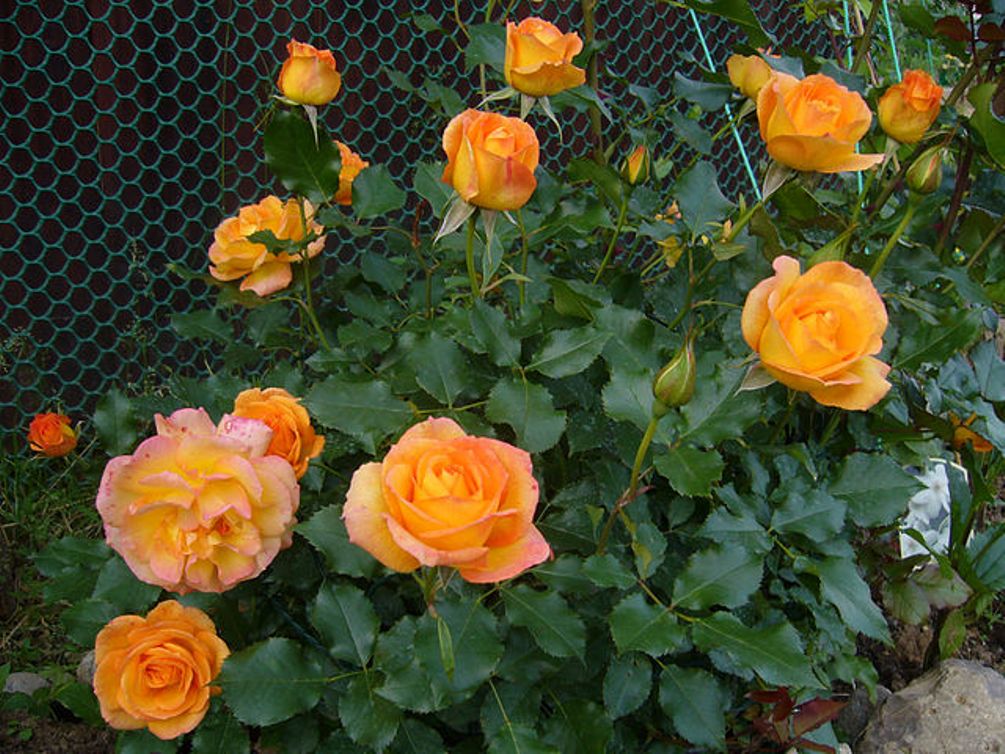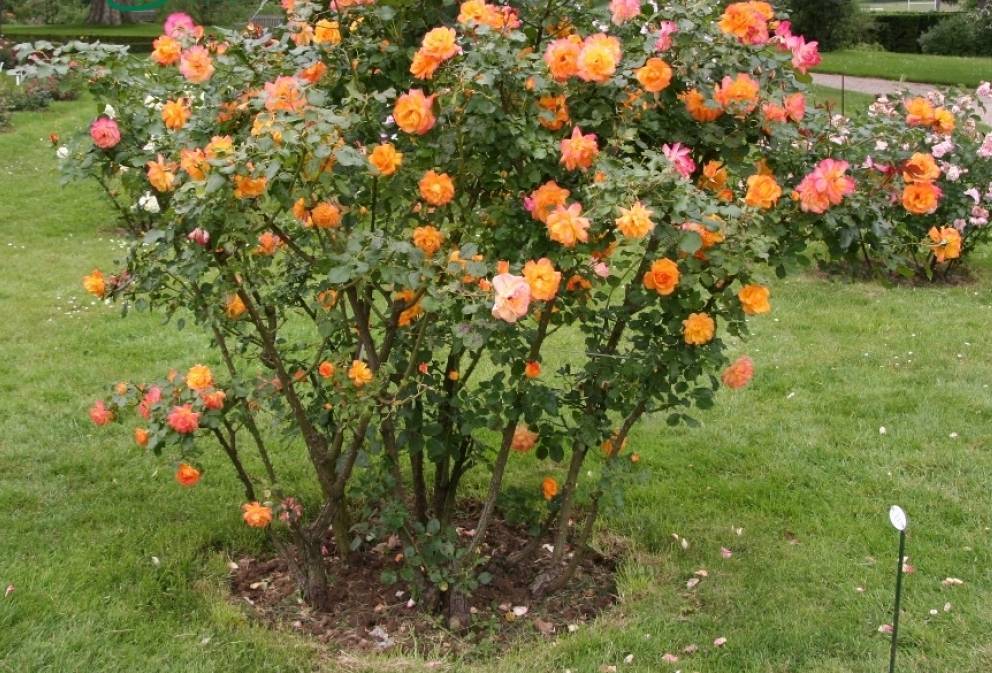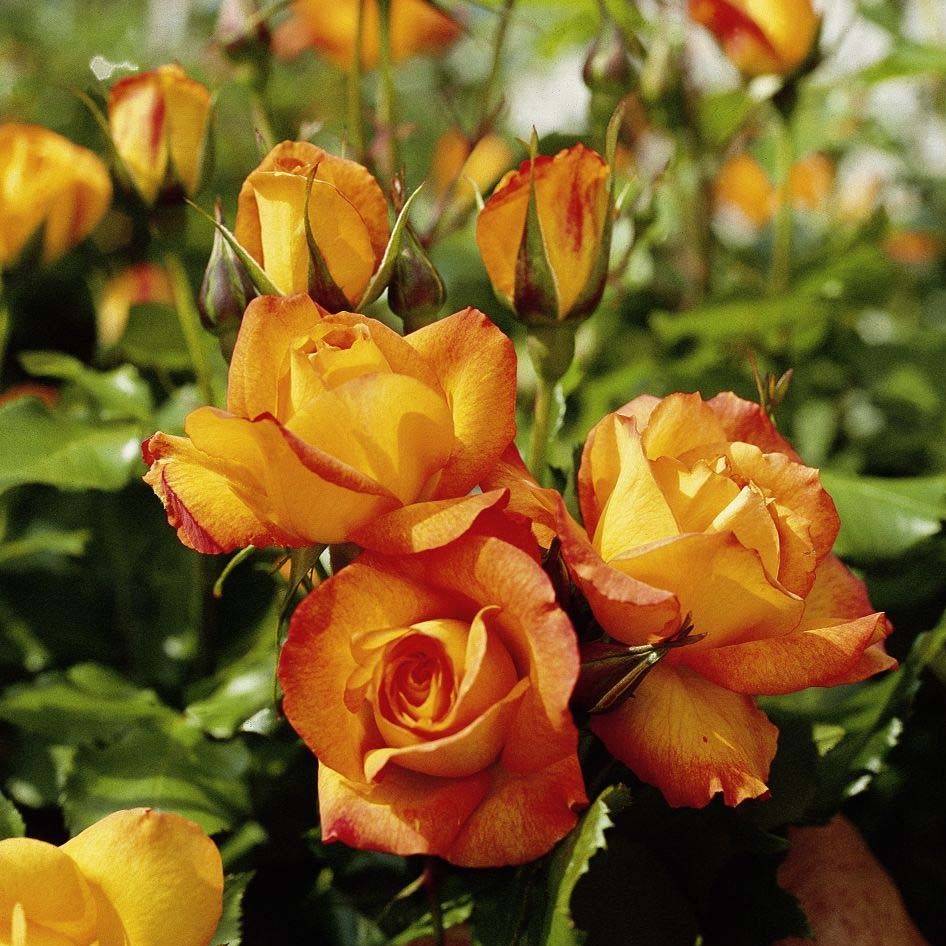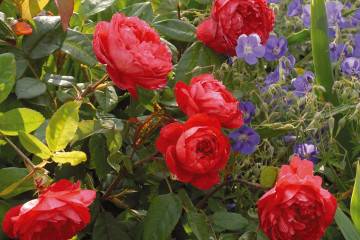Rose Sahara (Sahara) - characteristics of a super resilient shrub
Content:
Rose Sahara attracts attention with its buds painted in warm colors. The most pronounced colors are yellow and orange. Below is information about planting and caring for the Sahara rose, about possible diseases and pests, and how to propagate a culture.
Rose Sahara - what is this variety
Rose Sahara was bred by German specialists in 1996. It got its name for the sandy shades associated with the famous desert.
Description and characteristics
The bushes reach a height of 150-200 cm. There are 1-3 flowers on the stem, the diameter of which varies from 8 to 10 cm. The buds are painted with a yellow-orange palette. There are no thorns on the stems.
The bushes have good immunity and average winter hardiness.
Advantages and disadvantages of the variety
The positive qualities include the following characteristics:
- unpretentious care;
- repetition of flowering;
- beautiful appearance;
- frost resistance;
- good immunity.
The disadvantages include the drooping of thin branches under the weight of the buds and the burning out of the petals by the end of flowering.
Use in landscape design
The bicolor rose Sahara can be planted singly or in combination with other plants. The bushes will look beautiful against the background of tall decorative deciduous crops. They can also be planted in the middle of short plants.
Growing a flower
Bushes need to be bought from trusted sellers, otherwise, at best, a florist can purchase a rose of a different variety, at worst - a rosehip. It is necessary to pay attention that there are 2-3 shoots on the plant, and the root system is well developed.
A rose is usually planted with seedlings purchased from a garden center. In the future, the planting material can be propagated independently by cuttings or layering. Gardeners do not plant seeds due to the complexity of the process.
The procedure is carried out in spring or autumn. In the first case, the bushes have time to take root well before the onset of cold weather. When planting in the autumn, the florist can see the shape and color of the buds of the plant being purchased.
Seat selection
The plot is selected sunny with shading at noon. Groundwater should not come close to the ground surface. The bushes will feel good when planted from the south side of the house.
How to prepare the soil and flower for planting
The territory is cleared of garbage, dug up, loosened. If the land is infertile, it is fed with nutrient mixtures. Clay soil is facilitated by the introduction of sand and peat.
Planting procedure step by step
Roses are capable of growing widely, therefore, when planting several bushes, the distance between the planting pits should be at least 2 m.The procedure is performed as follows:
- Dig a hole 1 m deep and 50 cm in diameter.
- Drainage from broken bricks, expanded clay, crushed stone is laid out on the bottom.
- Then the substrate is poured, consisting of garden soil, humus, peat, sand with the addition of bone meal and superphosphate.
- A rose bush is placed in the middle of the hole, covered with soil along the root collar.
- Lightly compact the soil, watered.
Plant care
In order for the Sahara rose to remain decorative for a long time, it must be properly cared for.
Watering rules and humidity
Watering the Sahara climbing rose is rare, but abundant. The water is used warm, settled. You need to water the root circle. The rose does not tolerate irrigation from above, because of this, powdery mildew may appear on the leaves.
Top dressing and soil quality
The bushes are planted in fertile soil. In the year of planting, fertilizer is no longer applied. Then organic and mineral nutrients are alternated. Especially their introduction is necessary in early spring, during the budding period, after flowering.
Pruning and replanting
In the fall, cut off thin, unripe shoots. In the spring, dry, diseased, frozen branches are removed. Pruning healthy shoots should not be too strong, or the bushes may weaken and not grow flowers in the current season.
Features of wintering a flower
Rose scrub Sahara can withstand frosts down to -20 ° C. If lower temperatures are expected, the lashes are bent to the ground, covered with spruce branches. The procedure is started after the temperature of -5 ° C will hold for 2-3 days. Snow will serve as a natural protection against frost.
Bloom
With short interruptions, the Sahara rose blooms from May to November. The description indicates that the color of the petals varies from rich orange to pale yellow. The edges of the flowers are covered with a pale pink palette. On the entire surface, the petals are covered with red dots by the end of flowering.
With proper care, the rose blooms annually. The buds may not bloom due to strong pruning, fungal diseases of the bushes due to excessive moisture. When the flowers begin to dry out, they need to be cut off, so new buds from the side buds will grow faster.
Flower propagation
The rose is propagated in the spring. To do this, cut cuttings 20 cm long with 3-4 buds. They are wrapped in newspaper, moistened, and placed in a plastic bag. Contain shoots at a temperature of 15 ° C. When roots appear on the cuttings, they are transplanted into containers.
Another commonly used way to propagate a rose is by layering. To do this, in the spring, the stems that have begun to curl are bent to the ground, pinned, covered with earth. During the season, the shoots are watered, loosened the soil, and weeds are removed. When young plants appear on the layers, they are separated from the mother bush, transplanted to a permanent place.
Diseases and pests
The Sahara rose has good immunity, but with improper care, it can lose its decorative effect and even die. The culture becomes sick with a fungus due to excessive watering, irrigation from above with cold water. The rule must be observed: the top layer of the earth between waterings must have time to dry out.
For prevention, the rose can be sprayed with fungicides. Of the pests, aphids can choose the Sahara. They get rid of it by spraying the bushes with insecticides.
The Sahara park rose is about 2 m high bushes with beautiful yellow-orange flowers. Caring for her is simple. If you correctly follow the requirements of culture, then you can admire the spectacular flowering from May to November.




















